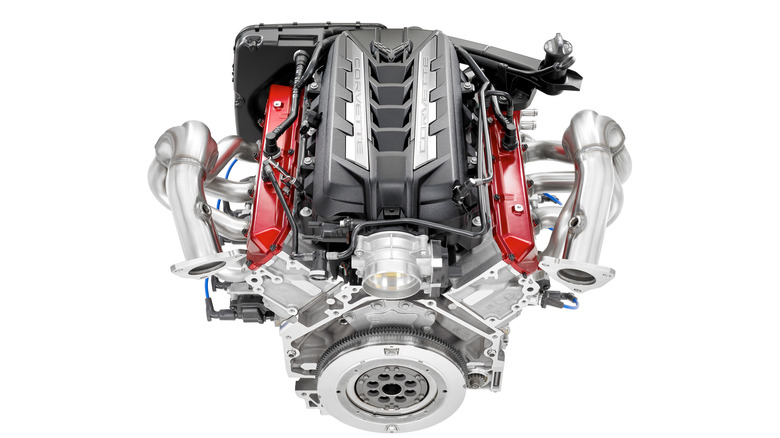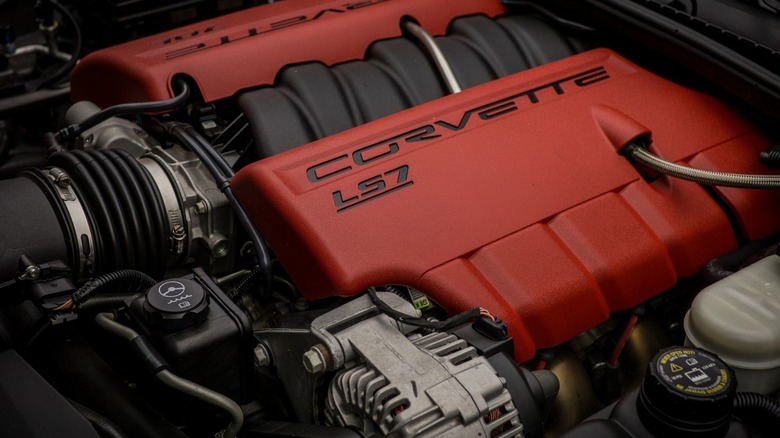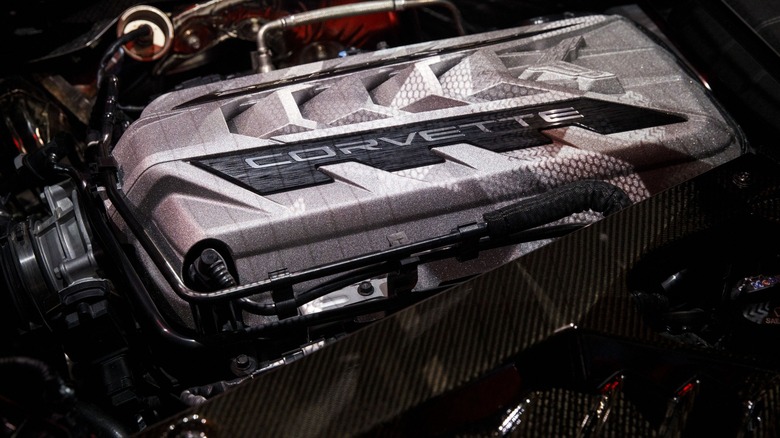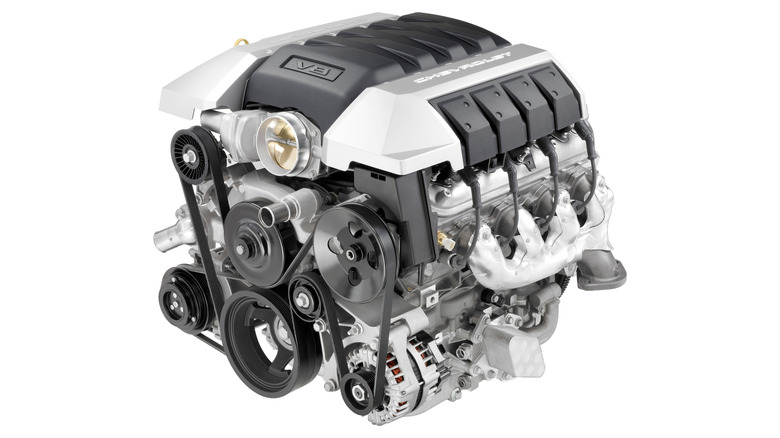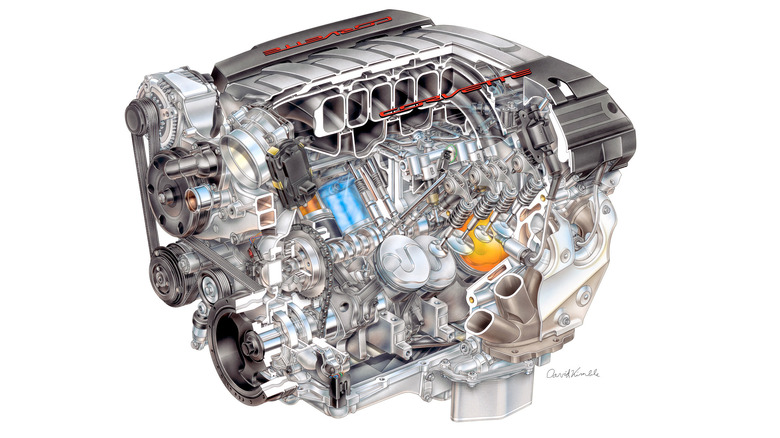General Motors LT Vs LS Engines: What Are The Big Differences?
Even if you've barely got your toe dipped into car culture, you're likely familiar with the term "LS Swap." You might even be familiar with what an LS is, but let's do a little recap here. The LS platform is a family of V8 engines from General Motors. Over the years, the engine and its iron-block platform-sharing family (found in trucks and vans) have made their way into virtually any vehicle chassis you can think of. Yes, even a Tesla.
The LS's compact footprint, light weight, and bolt-on power capabilities have put its popularity on a linear upward path since its debut in 1997. However, the re-birth of a classic GM engine, the LT namesake, has recently put thoughts of an LS swap on the back burner for some. There's a lot of confusing nomenclature throughout all of these historic engines. To keep things modern, our comparison will be between Gen-III and Gen-IV LS engines and the Gen-V LT engines. If that's still confusing, don't worry, we'll break it down for you.
General Motors LS engine: a living legend
The first car ever to get the legendary LS platform was the Chevrolet Corvette in 1997. From there, the potent aluminum-block LS1 made its way to the Camaro. Then GM started producing cast-iron block variants for trucks and SUVs spanning the range of standard Silverado 1500s to full-blown commercial vehicles.
This family of engines is colloquially known as Gen-III and Gen-IV small-block GM V8 engines. They come in a myriad of configurations with varying block materials, displacements, piston sizes, and power output. However, across all of them, the engine block remains consistent.
The LS engine is like a car enthusiast's Lego set in that virtually all of the parts are interchangeable between them. It's a simple cam-in-block pushrod V8 that's relatively easy to assemble and disassemble. So, one could pull a 4.8-liter example out of a junkyard van and bolt a set of high-flowing LS3 cylinder heads to the top, a Corvette intake manifold, a spicier camshaft, and voilà! You've got yourself a potent V8 with plenty of grunt and a relatively reasonable price tag.
General Motors LT engine: a long-lost relative returns
Let's be clear here. The LT namesake has been around since 1970. However, the engine we are covering is specifically the LT family of engines that entered production in 2014 with the introduction of the C7 Corvette. Colloquially known as the Gen-V small-block GM V8, it builds on all the lessons and successes of the LS platform.
Though bearing the same name as the older engines, the current LT came from a ground-up engineering effort from GM and is effectively entirely different from its older counterparts. It still largely uses standard cam-in-block pushrod V8 tech like the older engine but features a host of modern tech.
One stand-out variant of the LT engine breaks the norm, though. It's the LT6 engine you'll find planted squarely in the middle of a C8 Corvette Z06. It also happens to be the most powerful naturally aspirated V8 engine ever put in a production car.
Let's examine what separates the LS and LT engine platforms. Though they are fairly similar, there are some key differences between them.
The same, but different
As mentioned above, both the LS and LT engines use the same general foundation. A cam-in-block pushrod V8 design that ties its roots to the same basic principals as the ever-popular Gen-1 Chevy 350 found in oh-so-many muscle cars and hot rods. The one exception is the above-mentioned LT6 from the Z06 because it's a clone of a Ferrari design. Otherwise, the basic idea of the Gen-III, Gen-IV, and Gen-V engines are the same. Let's see where they differ.
The LT engine uses an aluminum engine block with a more robust design than the LS. Its water jackets around the cylinders are gusseted, whereas the LS's jackets are wide open, creating a weak point when power starts getting turned up. In addition, the LT features oil jets that spray the bottoms of the pistons to keep them cool, allowing higher compression ratios and less friction. Finally, forged connecting rods and a forged steel crankshaft mean the LT is more optimized for power than an LS. Effectively, GM addressed the LS's structural weak points and corrected them with the LT.
The LS family uses standard multi-port fuel injection with injectors spraying into the intake manifold. Fuel makes its way into the combustion chamber by way of the intake valves. The LT, on the other hand, uses direct injection, meaning the injectors spray fuel directly into the combustion chamber. This is more efficient and also allows more power.
More advanced engine tech
GM changed up the cylinder head design, too. The intake and exhaust valves are in opposite positions on the newer LT engine than they were in the LS. This allows better cylinder head flow and moves the spark plugs to a position that promotes better combustion. Once again, more efficient fuel usage and better flow means more power.
Some LS engines did leave the factory with variable valve timing (VVT), but it wasn't a very advanced VVT system. Effectively, it was either on or off, like Honda's original VTEC system. However, the LT uses an active VVT system that continuously alters timing based on various conditions to make for truly efficient operation. The cam phaser can adjust the angle of the camshaft by up to 62 degrees, a monumental jump from the LS's 20-degree variation. This allows the Gen-V LT engine to make plenty of torque at higher RPMs without sacrificing horsepower.
Finally, the LT features a host of other tech upgrades like an advanced engine control unit, a dual-stage oil pump to ensure proper oil pressure throughout all ranges of operation, a high-flowing intake manifold, and even an air induction humidity sensor to monitor how much water is getting into the engine to optimize combustion efficiency.
